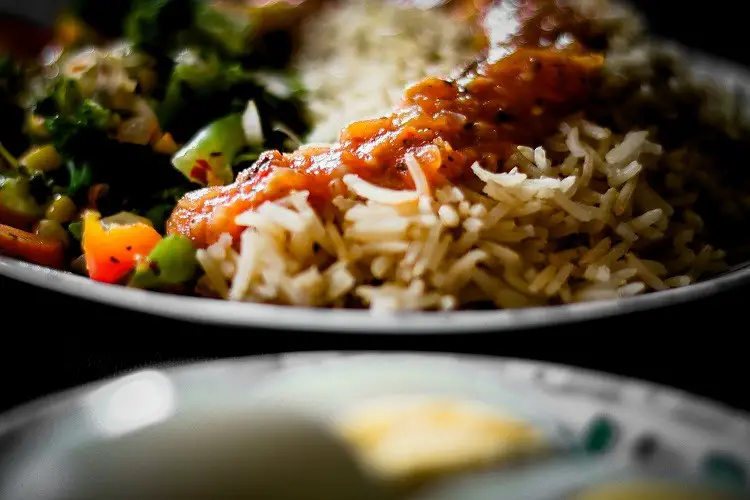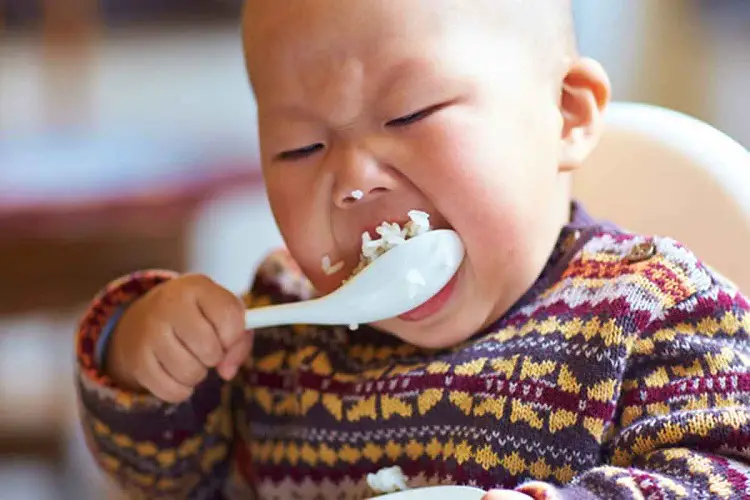Rice is a major source of carbohydrates which is the body’s main source of energy. If your toddler likes to eat rice, it could mean good or bad news depending on the extent.
There are also a few healthy recipes we have outlined for you to try out.
Before we dive in, let’s consider the types of rice available, the health benefits of eating rice, its nutritional value, and when it becomes too much.
Toddler Likes To Eat Rice
Having a picky-eating toddler can sometimes feel like dealing with an overbearing boss.
You’re always on your toes on what to do next to keep them satisfied. If your toddler likes to eat rice, it might mean both good and bad news for you.
The Good News
Rice is healthy and needed. It provides the body with adequate carbohydrates which serve as the body’s fuel to carry out tasks.
Not only that, rice also contains a variety of vitamins and minerals that help with oxygen transportation, heart health, and the digestive system.
Since toddlers are usually hyperactive, adding rice to their diet to replenish lost energy is a good start.
The Bad News
There can be too much. Yes, excessive consumption of any food at all no matter how nutritious could cause harm.
This is the same with overeating rice. Eating too much rice without the other necessary nutrients can lead to kwashiorkor. But not many people know when it becomes too much.
Kwashiorkor also known as edematous malnutrition is a type of malnutrition caused by extreme protein deficiency.
It is characterized by fatigue, thirst, loss of appetite, low body temperature, weight loss, and emaciated body parts.
What Is Rice
Rice is a popular main ingredient for different dishes across the world. It is widely consumed in countries like India, China, African countries and America.
It is so popular that the recipes are inexhaustible and can be cooked, steamed, blended into a purée, or as a gluten-free flour mix.
But not all rice is the same, there are different types and varieties of rice available. However, the varieties of rice are classified based on their starch profile, length, and color.
Types of Rice
Although there are over 40,000 varieties of rice, they can only fall within three classes of rice grains namely; Long grains, medium-sized grains, and short grains.
The difference in the varieties of rice available is based on their starch content.
Brown rice
Brown rice is the unrefined form of white rice, it is not necessarily a type of rice per se. It is unpolished, rough in texture, and has a flavourful taste to it.
Due to its unprocessed nature, it’s not as visually appealing as white rice, but it is a rich source of fiber, manganese, vitamins, magnesium, and selenium. It is also considered as whole grains.
White rice
This is the well-processed, polished, and packaged form of rice. Due to the polishing and processing, preservatives are included to extend its shelf life. White rice is equally nutritious, it doesn’t contain fiber but it is a source of folate.
Long grain rice
The long grain is a white hard type of rice that doesn’t stick together after cooking, it usually has lesser starch content and is included in most weight loss diets. Examples of long-grain rice include jasmine and basmati rice.
Medium grain rice
Unlike the long grain, medium grain rice is tender, moist, and sticks together during preparation. The sticking is due to the higher starch profile. An example of medium-grain rice is Valencia rice.
Short grain rice
Short-grain rice is originally from Japan. It is softer, moister, and stickier than medium-grain rice. It can be easily molded into different shapes for aesthetics. Examples of short-grain rice are Arborio and Sushi rice.
Kids-Friendly Rice Recipe

Fortunately, rice is an easy-to-maneuver type of food. It easily blends with different ingredients and food types.
The easy-to-make recipes with affordable ingredients that contain the other necessary nutrients are available in both print and on the web.
For a start, here are a few recipes to prepare rice for your toddler without omitting the other nutrients:
Cheesy Rice
This is a very simple recipe that many kids enjoy, hopefully, yours will as well. It involves boiling the rice until tender, adding butter, and enough shredded cheese, and mixing.
It can be served with vegetables like curly flowers, lettuce, carrots, and sweet corn just as your toddler loves it.
Kids-Friendly Fried Rice
Fried rice is an all-time favorite for many people, if adults can enjoy it so much, how about the kids? Only this recipe is a little less technical and spicy.
Ingredients include:
½ teaspoon of minced garlic and ginger
½ cup of soft-boiled rice.
1 tablespoon of oil (coconut, olive, or avocado oils are great options)
Diced carrots and spring onions
Frozen peas
2 beaten eggs
Soy sauce or a healthy seasoning of your choice.
Instructions
In a heated nonstick pan, add the oil and the minced garlic and ginger immediately and let it simmer.
Add your vegetables and stir until well combined and add the boiled rice.
After 2 minutes of adding the rice, pour the beaten eggs and stir until it is well cooked.
Add soy sauce and mix thoroughly, then let it simmer for 2 minutes more until it is ready.
Serve with freshly homemade juice or just water.
5 Benefits of Eating Rice
There are several benefits of eating rice with the most popular of them being that it is a major source of carbohydrates, an essential nutrient the body needs for survival.
However, there are other benefits as well we have outlined the top 5 benefits of including rice in your diet:
Diabetes Control
Brown rice has a glycemic index of 64, while that of white rice is 55, making brown rice a better choice for regulating blood sugar. With the 55 glycemic indexes of white rice, it is more likely to cause a spike in blood sugar as asserted by some studies.
Heart Health
The fiber content in brown rice helps to lower cholesterol levels, consequently reducing the risk of heart disease and stroke.
Reduced Cancer Risk
Brown rice contains three major phenolics or naturally occurring antioxidants that are found in plants.
These antioxidants help to prevent free radicals from damaging healthy cells.
This is the reason cancer survivors are encouraged to consume brown rice instead of white rice because the phenolics are deposited in the bran layer of the rice, when the rice is polished, it loses most of these antioxidants.
Digestive Health
The fiber in brown rice helps with bowel movement and digestive health.
Especially for people with celiac disease who have difficulty digesting some grains, eating gluten-free brown rice helps their body to get all the nutrients they need.
Weight Maintenance
Fibre creates a feeling of fullness in the stomach, which prevents you from eating extra, thereby maintaining a healthy weight.
Brown rice also contains other vitamins and minerals that help the blood to take oxygen around the body.
Even though some people prefer brown rice over white rice, it all boils down to preference and what they hope to achieve, not necessarily that it is better than white rice.
If you’re interested in maintaining a healthy weight, opting for brown rice will provide you with a healthy dose of the nutrients you need.
Related Posts:
- 30+ finger foods for a one-year-old
- Healthy recipes for picky eaters on a budget
- How To Make Avocado And Banana Puree For Babies
Conclusion
It is a normal occurrence for many parents to at some point in their parenting journey, have kids whoer picky eaters.
To be more specific, if your toddler likes to eat rice, don’t fret about it because it is a normal experience, and with a few more recipes added to the already suggested ones here, you wouldn’t have to worry about how much rice they consume.
